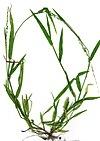
Poaceae or Gramineae is a large and nearly ubiquitous family of monocotyledonous flowering plants known as grasses. It includes the cereal grasses, bamboos and the grasses of natural grassland and species cultivated in lawns and pasture. The latter are commonly referred to collectively as grass.

Ranunculaceae is a family of over 2,000 known species of flowering plants in 43 genera, distributed worldwide.

Asphodelaceae is a family of flowering plants in the order Asparagales. Such a family has been recognized by most taxonomists, but the circumscription has varied widely. In its current circumscription in the APG IV system, it includes about 40 genera and 900 known species. The type genus is Asphodelus.

Panicoideae is the second-largest subfamily of the grasses with over 3,500 species, mainly distributed in warm temperate and tropical regions. It comprises some important agricultural crops, including sugarcane, maize, sorghum, and switchgrass.

Brachyelytrum is a genus of North American and East Asian plants in the grass family, classified in its own tribe Brachyelytreae.

Pteridaceae is a family of ferns in the order Polypodiales, including some 1150 known species in ca 45 genera, divided over five subfamilies. The family includes four groups of genera that are sometimes recognized as separate families: the adiantoid, cheilanthoid, pteridoid, and hemionitidoid ferns. Relationships among these groups remain unclear, and although some recent genetic analyses of the Pteridales suggest that neither the family Pteridaceae nor the major groups within it are all monophyletic, as yet these analyses are insufficiently comprehensive and robust to provide good support for a revision of the order at the family level.

The Stipeae are a tribe of grasses within the subfamily Pooidae, with up to 600 described species.

Oryzoideae (syn. Ehrhartoideae) is a subfamily of the true grass family Poaceae. It includes around 120 species in 19 genera, notably the major cereal crop rice. Within the grasses, this subfamily is one of three belonging to the species-rich BOP clade, which all use C3 photosynthesis; it is the basal lineage of the clade.

The Puelioideae is a subfamily of the true grass family Poaceae with two genera, Guaduella and Puelia, each in its own tribe. Its members grow in the understory of rainforests.
Anomochlooideae is a subfamily of the true grass family Poaceae. It is sister to all the other grasses. It includes perennial herbs that grow on the shaded floor of forests in the Neotropics. There are two genera, Anomochloa and Streptochaeta, each in its own tribe.

Danthonioideae is a mainly southern hemisphere subfamily of grasses, containing the single tribe Danthonieae and one unplaced genus, with altogether roughly 300 species. It includes herbaceous to partially woody perennial or annual (less common) grasses that grow in open grasslands, shrublands, and woodlands. It belongs to the PACMAD clade of grasses, but unlike some other lineages in that clade, grasses in the Danthonioideae exclusively use the C3 photosynthetic pathway. Its sister group is the subfamily Chloridoideae.

The PACMAD clade (previously PACCMAD, PACCAD, or PACC) is one of two major lineages (or clades) of the true grasses (Poaceae), regrouping six subfamilies and about 5700 species, more than half of all true grasses. Its sister group is the BOP clade. The PACMAD lineage is the only group within the grasses in which the C4 photosynthesis pathway has evolved; studies have shown that this happened independently multiple times.

Paniceae is a large tribe of the subfamily Panicoideae in the grasses (Poaceae), the only in the monotypic supertribe Panicodae. It includes roughly 1,500 species in 84 genera, primarily found in tropical and subtropical regions of the world. Paniceae includes species using either of the C4 and C3 photosynthetic pathways, as well as presumably intermediate species. Most of the millets are members of tribe Paniceae.

Micrairoideae is a subfamily of the grass family Poaceae, distributed in tropical and subtropical regions. Within the PACMAD clade, it is sister to subfamily Arundinoideae.

Paspaleae is a tribe of the Panicoideae subfamily in the grasses (Poaceae), native mainly to the tropical and subtropical Americas but with a number of species introduced to other regions. It includes roughly 680 species in 39 genera. Species in this tribe use either of the C3 or C4 photosynthetic pathways.
Steyermarkochloeae is a tribe of the Panicoideae subfamily in the grasses (Poaceae), native to tropical South America. There are only two species in two genera, Arundoclaytonia and Steyermarkochloa. The tribe probably belongs to a basal lineage within the subfamily. Species in this tribe use the C3 photosynthetic pathway.

Tristachyideae is a tribe of the Panicoideae subfamily in the grasses (Poaceae), native to tropical and subtropical regions of Africa, Asia, and South America. There are around 70 species in eight genera. The tribe belongs to a basal lineage within the subfamily, and its genera were previously placed in tribes Arundinelleae or Paniceae, subfamily Arundinoideae, or the now-obsolete subfamily Centothecoideae. Species in this tribe use the C4 photosynthetic pathway.

Zeugiteae is a tribe of the subfamily Panicoideae in the grasses (Poaceae), native to Africa, Asia, Australasia, South and Central America. There are 18 species in four genera. The tribe belongs to a basal lineage within the subfamily. Species in this tribe use the C3 photosynthetic pathway.

Chasmanthieae is a small tribe of grasses in the subfamily Panicoideae. It belongs to a basal lineage within the subfamily and has only seven species in two genera, Bromuniola with one species in Africa and Chasmanthium from North America. They all use the C3 photosynthetic pathway.
Cyperochloeae is a small tribe of grasses in the Panicoideae subfamily, found in Australia. It belongs to a basal lineage within the subfamily and has only two species in two monotypic genera, Cyperochloa and Spartochloa. They use the C3 photosynthetic pathway.


















